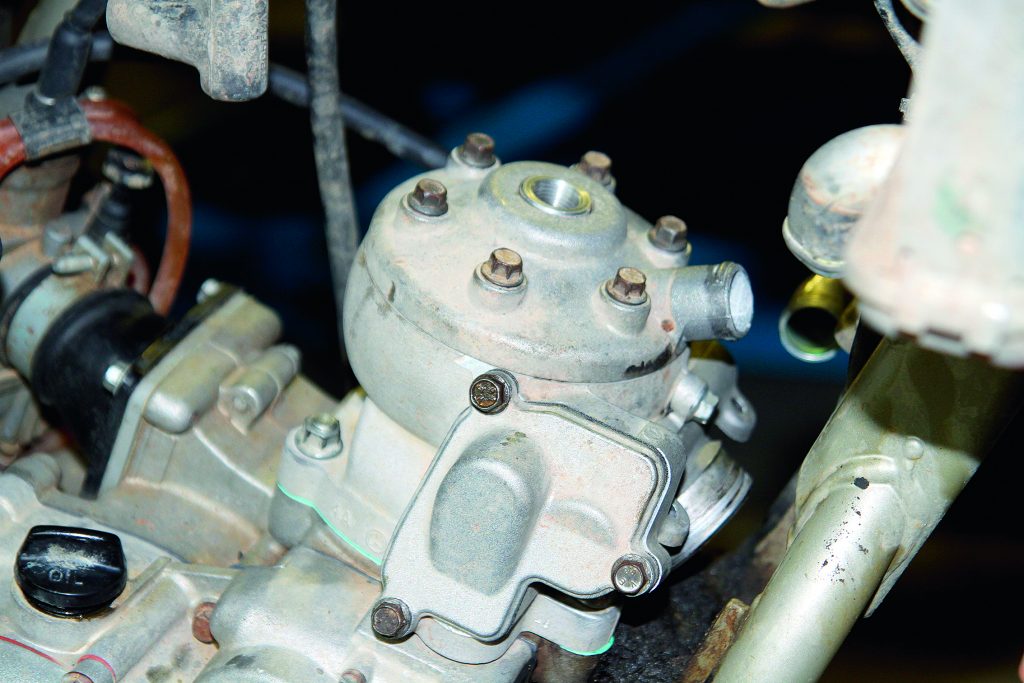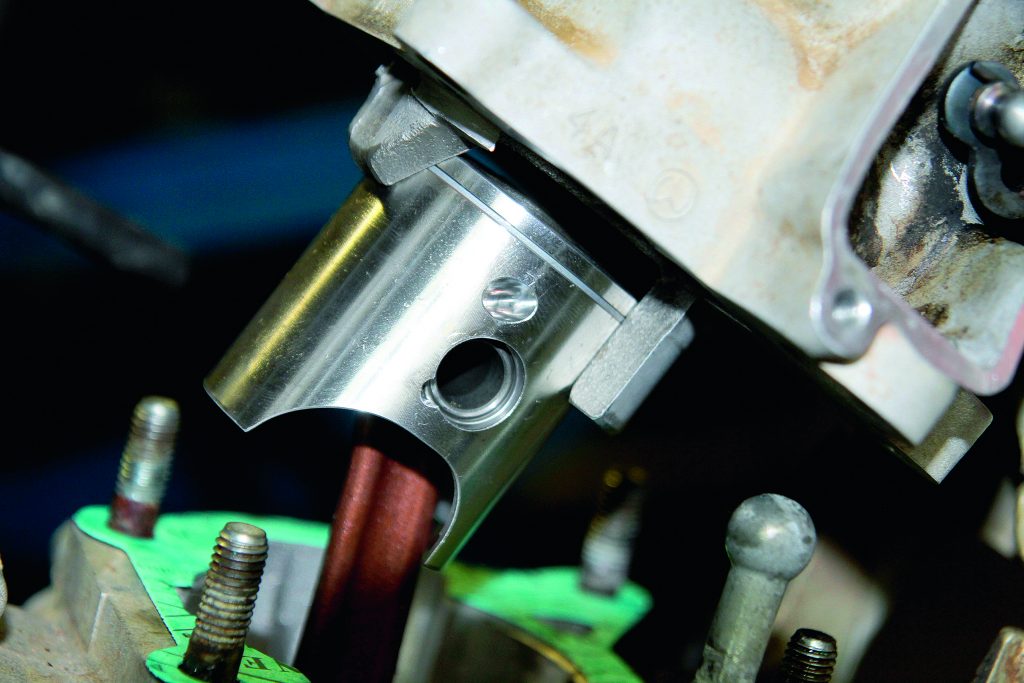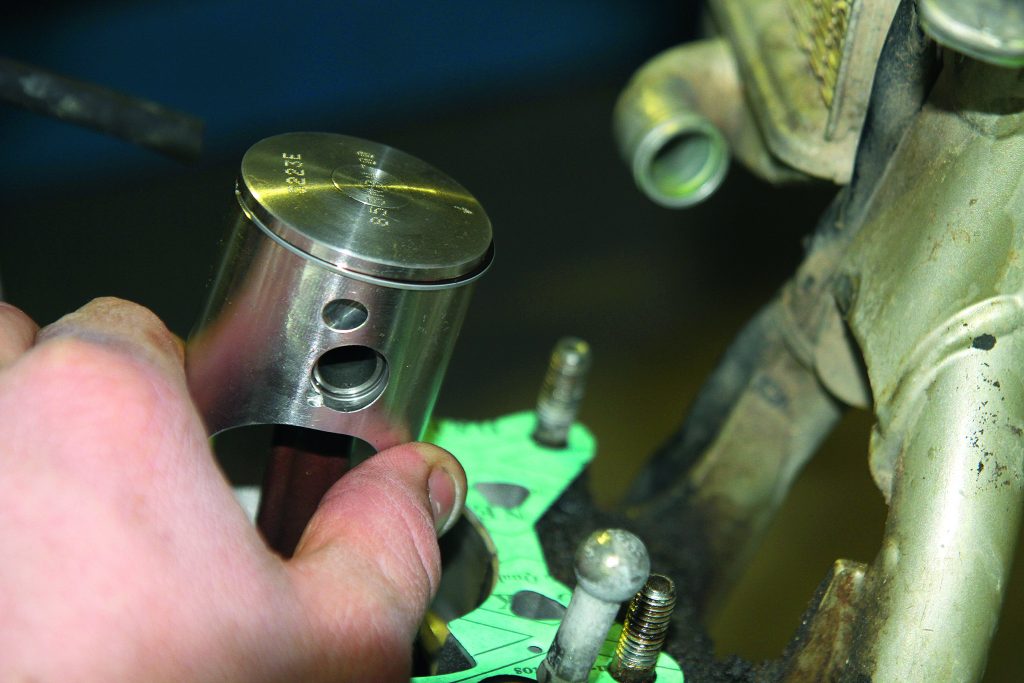A worn piston and rings won’t form a tight seal in the cylinder, which can scuff the bore and will starve your engine of power. Fitting a new piston to a two-stroke top end will protect your engine from expensive damage; if a weakened piston cracks after hours of abuse it can cause all sorts of strife.
STEP 1: CLEAN ACCESS
During a top-end rebuild, your dirtbike’s most highly stress components will be open to the elements, so ensure you clean your bike thoroughly and completely dry it before taking it apart. Pull the seat off to open up some room so it is easy to get your tools in and then disconnect the fuel line from the carburettor or the injector. Remove the tank, taking with it the radiator shrouds, and now you should have unobstructed access to the top of the engine.

STEP 2: FLUIDS AND PIPE OUT
Remove the coolant drain bolt and empty the engine and radiators of all coolant. Once all the coolant is out of the radiators disconnect the radiator hoses from the engine and remove the spark plug. Using a spring puller, remove the two expansion chamber springs, undo the pipe mounts and remove the pipe.

STEP 3: CYLINDER OFF
Undo the four cylinder mount bolts, the power-valve cover and disconnect the linkage arm, and with the engine mounts removed slowly work the cylinder up off the mounting studs until it is clear of the piston. With the cylinder removed, the bottom-end will be fully exposed so ensure you stuff a clean rag around the conrod so no dirt enters the engine. With the cylinder off take the opportunity to hone the bore.

STEP: 4 PISTON OFF
Remove one of the circlips and use a small socket to push the wrist pin through the piston and out the side. The piston will now come off the conrod. It’s a good idea to replace the top-end bearing as it too takes a lot of abuse.

STEP 5: NEW PISTON
Remove the old base gasket and clean the surface with a rough cloth before carefully fitting the new one over the mounting studs. Lightly oil the new top-end bearing and slide it into the conrod. Place the new piston over the conrod and insert the new wrist pin through the piston, ensuring the arrow on the top of the piston points towards the front of your bike. Install the new circlips that came in the kit.

STEP 6: GUIDE IT IN
Lightly oil the cylinder walls and guide the piston into the cylinder. Tighten the cylinder base nuts using a ring spanner and, if you can, use a torque wrench to ensure the cylinder is tightened evenly. Install the engine mounts and reconnect the power-valve arm and seal it with the cover.
Reconnect all the radiator hoses making sure the hose clamps are tight around the joins and fill up your radiator with coolant. Install a new spark plug and connect the lead so your bike’s got a fresh spark. Throw the tank, shrouds and seat back on, hold your breath and give it a kick. Mat Boyd

TWO-STROKE TOP END TIPS
DON’T FORGET
FEEL THE PRESSURE: The good thing about an older-style two-stroke is that you get a fair idea of the bike’s compression from kicking it over. If it’s too easy to kick over, you know you’ve got problems. If you’ve got an electric-start two-stroke that spins over easily from cold you’ve definitely got problems.
The best way to check the condition of the cylinder is by removing the sparkplug and using a compression tester.
Dos
Cover the opening to the bottom-end once you have removed the cylinder, to prevent dirt from getting in.
Torque the cylinder base nuts and the cylinder-head bolts so there is even pressure on the gaskets.
Apply a small amount of oil to the cylinder walls and the piston before reassembling the top-end.
Don’ts
Remove the cylinder without cleaning the bike first.
Fit the new base gasket onto a dirty surface; you need to ensure the base is clean and smooth before fitting the new gasket.
Forget to refill the coolant! It can be easy to do if you haven’t done a top-end rebuild before.